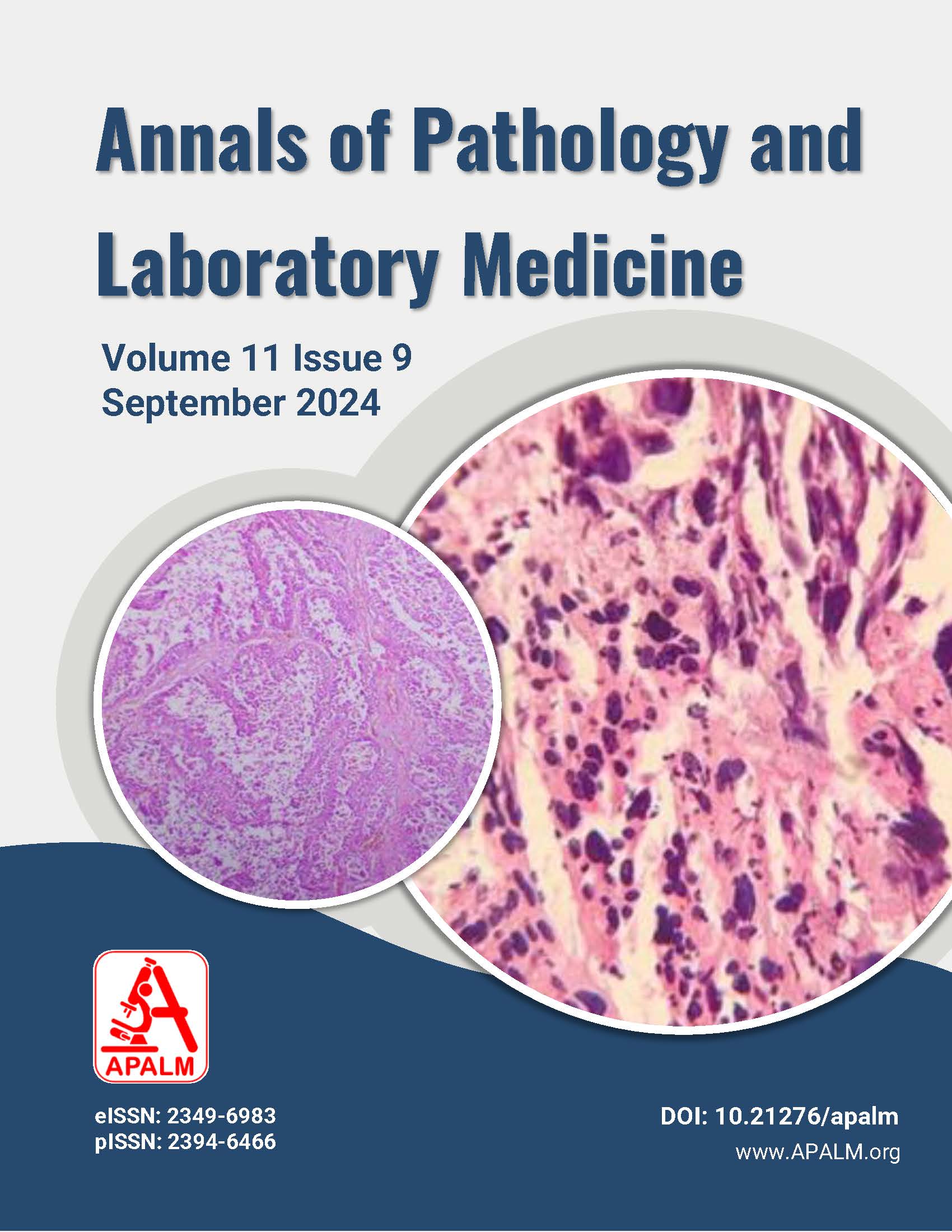Application of The International System for Reporting Serous Fluid Cytopathology (TIS) on Reporting Various Body Fluids: A Study from a Tertiary Care Hospital of Western India
DOI:
https://doi.org/10.21276/apalm.3378Keywords:
Serous fluid, Classification, Effusion, Cytopathology, MalignancyAbstract
Background: Serous effusion is the accumulation of fluid in body cavities due to various causes, with malignancies being one of the important contributors. The various sites from which fluid can be sent for analysis include the pleural, peritoneal, and pericardial cavities.
Materials and Methods: This was a retrospective observational study. A total of 114 fluids were studied. All received body fluid samples sent to the cytopathology section of the pathology department, including pleural and peritoneal fluids, were examined, excluding sputum and broncho-alveolar lavage fluid. Wherever available, histopathological samples from the same patient were used for correlation.
Results: A total of 114 fluids were studied. Histopathological correlation was available in 30 cases. Epithelial malignancy, including adenocarcinoma, was the most common malignancy involving pleural effusion and peritoneal fluid.
Conclusion: The international system of reporting is a user-friendly framework that can be easily applied to effusion fluid for better patient management and effective communication with clinicians. Due to the well-documented outcomes from adopting uniform cytology terminology for other organ systems, we recommend the use of this classification and believe its use will be paramount in improving diagnostic yield in effusion cytology.
References
Kolte S, Zaheer S, Aden D, Ranga S. Application of the international system for reporting serous fluid cytopathology on reporting various body fluids; experience of a tertiary care hospital. Cytojournal. 2022;19:52.
Ahuja S. The international system for reporting serous fluid cytopathology along with diagnostic pitfalls of serous effusion cytology. 2022.
Shidham VB, Layfield LJ. Approach to diagnostic cytopathology of serous effusions. Cytojournal. 2021 Dec 6;18:32.
Pinto D, Chandra A, Crothers BA, Kurtycz DFI, Schmitt F. The international system for reporting serous fluid cytopathology—diagnostic categories and clinical management. J Am Soc Cytopathol. 2020 Nov-Dec;9(6):469-77.
Pinto D, Chandra A, Schmitt F. The International System for Reporting Serous Fluid Cytopathology: How to Incorporate Molecular Data in Cytopathology Reports. J Mol Pathol. 2021;2(2):66-76.
Pergaris A, Stefanou D, Keramari P, Sousouris S, Kavantzas N, Gogas H, et al. Application of the International System for Reporting Serous Fluid Cytopathology with cytohistological correlation and risk of malignancy assessment. Diagnostics (Basel). 2021 Nov 28;11(12):2223.
Sachan R, Gupta A, Awasthi P. Application of international system for reporting serous fluid cytology in effusion samples—a prospective study in an oncology setting. 2023 Sep-Oct;351-61.
Lee YM, Hwang JY, Son SM, Choi SY, Lee HC, Kim EJ, et al. Comparison of diagnostic accuracy between CellPrepPlus and ThinPrep liquid-based preparations in effusion cytology. Diagn Cytopathol. 2014;42:384-90.
Farahani SJ, Baloch Z. Are we ready to develop a tiered scheme for effusion cytology? A comprehensive review and analysis of the literature. Diagn Cytopathol. 2019;47:1145-59.
Hou T, Landon G, Stewart J, Roy-Chowdhuri S. The value of a tiered cytology diagnostic reporting system in assessing the risk of malignancy in indeterminate serous effusions. Cancer Cytopathol. 2021;129:75-82.
Lobo C, Costa J, Petronilho S, Monteiro P, Leca L, Schmitt F. Cytohistological correlation in serous effusions using the newly proposed International System for Reporting Serous Fluid Cytopathology: experience of an oncologic center. Diagn Cytopathol. 2021;49:596-605.
Kundu R, Srinivasan R, Dey P, Gupta N, Gupta P, Rohilla M, et al. Application of Indian Academy of Cytologists Guidelines for Reporting Serous Effusions: An Institutional Experience. J Cytol. 2021;38:1.
Ebata T, Okuma Y, Nakahara Y, Yomota M, Takagi Y, Hosomi Y, et al. Retrospective analysis of unknown primary cancers with malignant pleural effusion at initial diagnosis. Thorac Cancer. 2016;7(1):39-43.
Sears D, Hajdu SI. The cytologic diagnosis of malignant neoplasms in pleural and peritoneal effusions. Acta Cytol. 2017;31:85-97.
Gecman C, Gecmen GG, Ece D, Kahyaoglu M, Kalayci A, Karabay CY, et al. Cytopathology of pericardial effusions: experience from a tertiary centre of cardiology. Herz. 2018;43:543-7.
Downloads
Published
Issue
Section
License
Copyright (c) 2024 Riya Satishbhai Visavadiya, Dimple Hardikbhai Darad, Mohmadovesh Mohmadyunus Panchbhaiya, Alaukika Naranbhai Rathwa

This work is licensed under a Creative Commons Attribution 4.0 International License.
Authors who publish with this journal agree to the following terms:
- Authors retain copyright and grant the journal right of first publication with the work simultaneously licensed under a Creative Commons Attribution License that allows others to share the work with an acknowledgement of the work's authorship and initial publication in this journal.
- Authors are able to enter into separate, additional contractual arrangements for the non-exclusive distribution of the journal's published version of the work (e.g., post it to an institutional repository or publish it in a book), with an acknowledgement of its initial publication in this journal.
- Authors are permitted and encouraged to post their work online (e.g., in institutional repositories or on their website) prior to and during the submission process, as it can lead to productive exchanges, as well as earlier and greater citation of published work (See The Effect of Open Access at http://opcit.eprints.org/oacitation-biblio.html).










